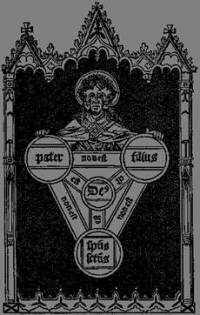ANALYSIS: ‘West's foreign policy only a secondary reason for hatred.’
by - 5th August 2016

CHRISTIAN doctrines that no Christian actually espouses once again provide fuel for the Islamic State propaganda machine.
Whipping up hatred against the West for religious beliefs it has barely heeded for a century is not without irony.
But in the latest issue of Dabiq magazine, it is clear that IS are doing a better job of reminding the West of its founding faith – while getting most of it wrong – than any amount of papal bulls or clerical press conferences.
The fifteenth issue of the eighty-page glossy takes on the Trinity which classical Islam views as polytheism, and so in contradiction to tawhid, ‘the defining doctrine of Islam’ according to the Oxford Dictionary of Islam.
Tawhid declares that God is one without a second. Shirk, the greatest of sins, is its polar opposite, and means associating anything, even thoughts but especially partners, with God.
The Qur’an Sura 4 verse 171 exhorts Jews and Christians – known as the People of the Book: ‘Do not exaggerate in your religion, nor utter anything concerning God save the truth. Verily the Messiah, Jesus son of Mary, was only a messenger of God, and His Word, which He committed to Mary, and a Spirit from Him. So believe in God and His messengers, and say not, “Three.” Refrain! It is better for you, God is only one God.’
This is possibly a reference to the tendency, still evident in remote Christian communities today, to identify the Trinity as Father, Son Jesus and Mother Mary, which is of course blasphemous.
The orthodox Christian position is set forth in the Athanasian Creed:
‘And the catholic faith is this: That we worship one God in Trinity, and Trinity in Unity; neither confounding the Persons; nor dividing the Essence. For there is one Person of the Father; another of the Son; and another of the Holy Ghost. But the Godhead of the Father, of the Son, and of the Holy Ghost, is all one; the Glory equal, the Majesty coeternal. Such as the Father is; such is the Son; and such is the Holy Ghost. … So the Father is God; the Son is God; and the Holy Ghost is God. And yet they are not three Gods; but one God.’
Attacking the Christian doctrines of the Trinity as shirk, the divinity of Christ as a blasphemous misunderstanding, and the atoning sacrifice of Christ as suggesting that God is unable in his own right to forgive sins, while also defending their own barbarities as divinely authorized and indeed obligatory, Dabiq asks of Christians:
‘How do they claim to be monotheistic and claim of Him as being the One and Only, the Merciful, the Just and Wise God yet they attribute to Him a mother, a son, a partner, and the Trinity, believe He is unable to forgive mankind for their “original sin” except by having one of His most beloved men unjustly bear their burdens and be crucified on their behalf, and declare that the laws He legislates are cruel, barbaric, and unfit for modern times?’
This possibly also refers to the erroneous Islamic idea of the Christian Jesus as a legislator, instead of the fulfilment and embodiment of the law’s meaning, which is love.
Mystery
In Christian thinking, the Trinity is considered a mystery. It is not some mathematical puzzle to be solved, but an expression of the divine love to be experienced.
It is not immediately obvious how the three ‘Persons’ of the Trinity can be both different and the same. Yet the finest Christian minds have not merely asserted that they are, but suggested ways in which this mystery can begin to be understood.
Dorothy Sayers, a theologian and Dante scholar in addition to being the author of the Lord Peter Wimsey detective stories, wrote an entire book, The Mind of the Maker, suggesting that the Trinity might be understood as being like three facets of the creative act of writing a book: the Father equivalent to the idea in the author’s mind, ‘the whole work complete at once, the end in the beginning’; the Son to the creative energy that does the writing, ‘working in time from the beginning to end’; and the Holy Spirit to the book’s impact, rippling out to touch the minds, hearts and souls of its readers.
This is good but unsatisfactory since the Son and the Spirit are not facets or aspects of God, but Persons.
Theologian-musician Professor Jeremy Begbie of Cambridge and Duke Universities, quotes the eminent musicologist Victor Zuckerkandl’s description of a three-note chord to get round this more satisfactorily:
‘Three tones sound. In each of them space encounters us and we encounter space. None of them is in a place; or better, they are all in the same place, namely, everywhere. Different places, juxtaposition, are out of the question. Yet there is order here, unmistakable and undeniable: a triad … order that we hear, not merely think: spatial order without difference of places, without juxtaposition.’
Zuckerkandl continues: ‘This is the problem. In the incisive light of Ernst Mach's formulation: "Why do three tones form a triad and not a triangle?" How can different things of the same kind be in space simultaneously without being at different places, without being in "juxtaposition"?’
Begbie finds in this musicological conundrum of a chord an apt analogy to the three Persons of the Trinity coexisting; at the same time distinct, yet One.
To the medieval mind, the Trinity could be explained in a diagram:
 The text within the diagram informs us that the Father, Son and Holy Spirit are not God, nor is the Father the Son, the Son the Spirit, or the Spirit the Father.
The text within the diagram informs us that the Father, Son and Holy Spirit are not God, nor is the Father the Son, the Son the Spirit, or the Spirit the Father.
This final example of a way to comprehend the Trinity is, if anything, even more imaginative than the other two.
The brilliant Cambridge computer pioneer, Margaret Masterman, was shown this diagram by a nun friend, Mother Geraldine Mary SSM, who suggested that the diagram could be mapped onto a logical diagramme of triads according to Boolean logic – the basis of contemporary computer design.
In a paper she published in 1967, Masterman showed that the statement of the Athanasian Creed could then be found in a reading of the Boolean diagramme. [Margaret Masterman, ‘Theism as a Scientific Hypothesis’, Theoria to Theory, April 1967, pp. 240-46.]
As should be apparent from these examples of explanations of what is in essence inconceivable to the human mind – creative, musical, and Boolean – we can recognize that the doctrine of the Trinity is not for Christians a denial of the unity of God so much as an unfolding of its mystery.
The Bible is replete with references to the fact that ‘the Lord your God is one God’. ‘You shall have no other gods before me’ is the very first of the Ten Commandments given to Moses, upon which Christian faith is founded.
Dabiq’s ill-educated writers, however, do not delve into the facts in their enthusiasm to ‘break the cross’ – making it clear that their objective remains fascist despite their avowed religiosity:
‘What’s important to understand here is that although some might argue that your foreign policies are the extent of what drives our hatred, this particular reason for hating you is secondary … The fact is, even if you were to stop bombing us, imprisoning us, torturing us, vilifying us, and usurping our lands, we would continue to hate you because our primary reason for hating you will not cease to exist until you embrace Islam.’
OXYGEN OF PUBLICITY
Why have we given yet more attention to the evil folly of ISIS? Analyst JM Berger, who almost single-handedly got Twitter to shut down a multitude of ISIS accounts, would say it is important to be accurately informed as to motivation. We also believe the French got it right when they cut off the ‘oxygen of publicity’ by refusing to post the names and photos of terrorists. We believe it is the ‘fame’ angle that needs to be starved, not analytic information itself. Dabiq magazine runs for eighty pages.
